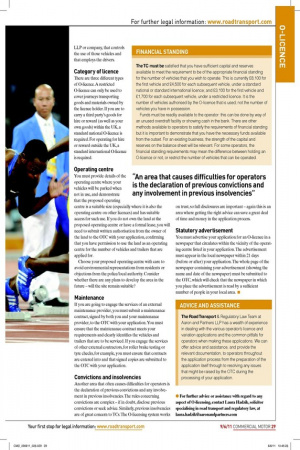Getting the right start
Page 23

Page 24

If you've noticed an error in this article please click here to report it so we can fix it.
Completing your O-licence application correctly first time can save a lot of trouble in the long run
Words: Laura Hadzik When applying for a new operator’s licence or making further applications to alter an existing licence you will need to complete the relevant application form and submit it to the Ofice of the Trafic Commissioner (OTC) at Leeds.
Alterations that require action include increasing the number of vehicles authorised under your 0-licence, adding a new transport manager or changing your operating centre.
Delays in the processing of applications cause operators huge frustration. However, by far the biggest reason for delayed or rejected applications is that operators do not complete the application form correctly or fail to include a required document.
The application process
Once you have completed the relevant application form and submitted it to the OTC, your application will join the queue of applications already awaiting processing.
If your application includes an incorrect or inadequate answer, or a required document is missing, the OTC will write to you requesting that you provide the omitted information or documentation. However, your application will go to the back of the queue and will have to wait its turn again.
It is therefore vital that the application form is completed correctly and that all required documentation is attached upon irst submission. However, there are some common pitfalls operators face when making applications.
The applicant
The O-licence must be held by the user of the vehicles to be authorised under the licence. It must be made in the name of the person or the legal entity, such as partnership, LLP or company, that controls the use of those vehicles and that employs the drivers.
Category of licence
There are three different types of O-licence. A restricted O-licence can only be used to cover journeys transporting goods and materials owned by the licence holder. If you are to carry a third party’s goods for hire or reward (as well as your own goods) within the UK, a standard national O-licence is required. For operating for hire or reward outside the UK, a standard international O-licence is required.
Operating centre
You must provide details of the operating centre where your vehicles will be parked when not in use, and demonstrate that the proposed operating centre is a suitable size (especially where it is also the operating centre on other licences) and has suitable access for such use. If you do not own the land at the proposed operating centre or have a formal lease, you will need to submit written authorisation from the owner of the land to the OTC with your application, conirming that you have permission to use the land as an operating centre for the number of vehicles and trailers that are applied for.
Choose your proposed operating centre with care to avoid environmental representations from residents or objections from the police/local authority. Consider whether there are any plans to develop the area in the future – will the site remain suitable?
Maintenance
If you are going to engage the services of an external maintenance provider, you must submit a maintenance contract, signed by both you and your maintenance provider, to the OTC with your application. You must ensure that the maintenance contract meets your requirements and clearly identiies the vehicles and trailers that are to be serviced. If you engage the services of other external contractors, for roller brake testing or tyre checks, for example, you must ensure that contracts are entered into and that signed copies are submitted to the OTC with your application.
Convictions and insolvencies
Another area that often causes dificulties for operators is the declaration of previous convictions and any involvement in previous insolvencies. The rules concerning convictions are complex – if in doubt, disclose previous convictions or seek advice. Similarly, previous insolvencies are of great concern to TCs. The O-licensing system works on trust, so full disclosures are important – again this is an area where getting the right advice can save a great deal of time and money in the application process.
Statutory advertisement
You must advertise your application for an O-licence in a newspaper that circulates within the vicinity of the operating centre listed in your application. The advertisement must appear in the local newspaper within 21 days (before or after) your application. The whole page of the newspaper containing your advertisement (showing the name and date of the newspaper) must be submitted to the OTC, which will check that the newspaper in which you place the advertisement is read by a suficient number of people in your local area. ■















































